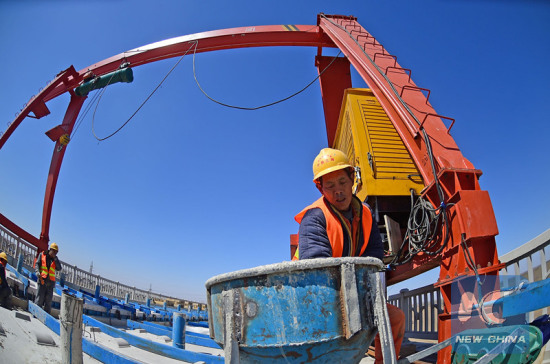
Workers work at the Liaoning section of a high-speed railway in northeast China's Liaoning Province, April 11, 2017.(Xinhua/Yang Qing)
While some say that China still relies on its traditional growth boosters for its strong results, the world' s second largest economy is making strides far beyond its expectation-beating growth.
Taking a closer look at China's 6.9-percent economic expansion in the first quarter, it is the increasing role of the consumption and service sectors, rather than infrastructure spending and credit growth, that deserves attention.
First-quarter GDP growth accelerated from 6.8 percent in the previous quarter, and 77.2 percent of it was driven by consumption, 12.6 percentage points higher than the 2016 level, according to official data.
Meanwhile, the service sector rose 7.7 percent year-on-year in the first quarter, outpacing a 3-percent increase in agriculture and 6.4 percent in the secondary industry. It accounted for 56.5 percent of the overall economy.
The Chinese economy has not only been able to avoid a "hard landing," but is stabilizing and improving with better structure and more jobs, according to Chinese Premier Li Keqiang Tuesday.
Mao Shengyong, a spokesperson with the National Bureau of Statistics(NBS), said the Chinese were spending more on services, and the domestic wave of innovations and entrepreneurship had brought in new businesses and new methods of consumption.
Innovation and start-ups are also a steady source of new jobs and income increase, with 3.34 million new jobs created in the first quarter and the surveyed unemployment rate staying under 5 percent.
The per capita real disposable income of Chinese nationwide increased 7 percent year on year in real terms, outpacing the GDP growth rate in the period, while that of rural residents rose at a faster pace of 7.2 percent.
The pickup in China's economic growth was not a result of short-term monetary stimulus, but rather increasing demand triggered by urbanization and supply-side structural reform, said Zhang Liqun, a researcher with the Development Research Center under the State Council.
Xu Hongcai, economist with the State Information Center, said the highlight of the first-quarter data was a pickup in private investment, which climbed 7.7 percent year-on-year, a significant increase from the 3.2 percent growth in 2016.
The reforms and other measures taken by the government to encourage private investment since the second half of 2016 have paid off, he said.
China has shifted away from pursuing breakneck expansion to facilitate further reforms as the government trimmed this year's growth goal to around 6.5 percent from a range of 6.5 to 7 percent for 2016.
At the same time, the country has set ambitious targets regarding structural adjustment such as creating 11 million new jobs and slashing steel production capacity by around 50 million tonnes and coal by at least 150 million tonnes.
China must speed up replacing old growth drivers with new ones to transform and upgrade the economy, said Premier Li, citing a challenging world economic recovery and relatively heavy downward pressure in the domestic economy.
The World Bank said in a report last week that China's transition to slower but structurally rebalanced growth had continued, and it expected the Chinese economy to slow gradually as it rebalanced toward consumption and services.
"Chinese policymakers will manage the balancing act," which means that they will continue with long-term structural reforms, support new growth engines and facilitate the economy transitioning towards services and high value-added products, said Sudhir Shetty, chief economist of the World Bank's East Asia and Pacific Region.
Mao said it was "no big deal" if economic growth slipped by a few tenths of a percentage points in the near future, noting that China's economic growth rate had become less volatile in recent years, with 6.9 percent for 2015, 6.7 percent for 2016 and 6.9 percent for the first quarter of 2017.
Other than spurring growth, the priority for China's economic policies must now be given to furthering supply-side structural reform to lay a solid foundation for medium and long-term development, said Zhang Liqun.


















































